Most Common Snakes In The Greater Houston Area
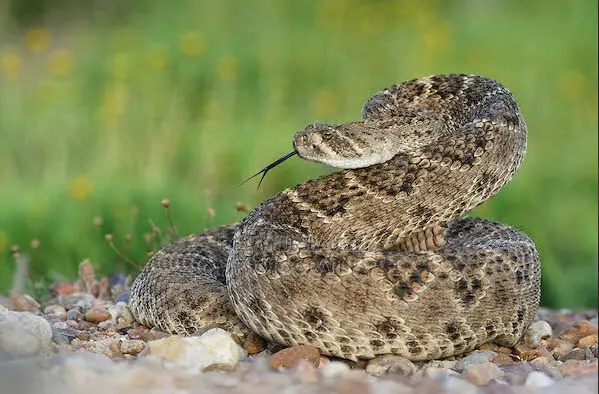
Most common Snakes In Our Neighborhood
The most common types of snakes in the Fulshear, Texas area. Learn about the non-venomous and venomous friends that live with us.
Flat-Head Snake
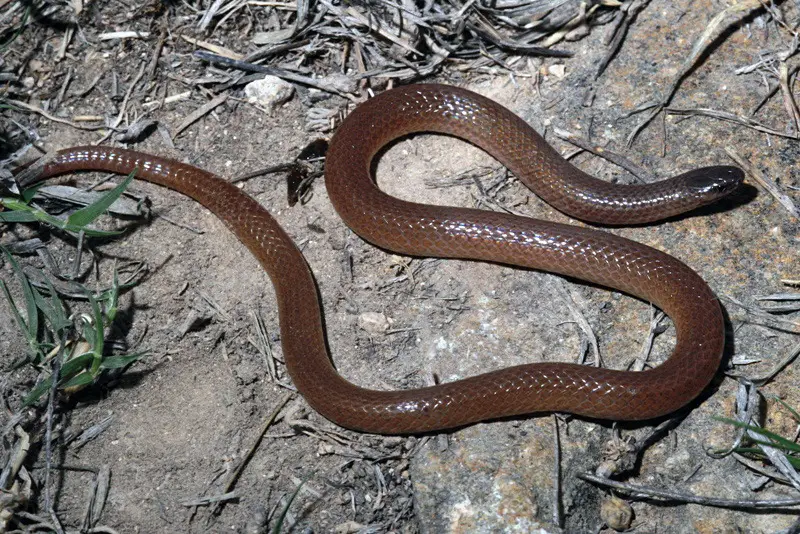
Habitat
The flat-headed snake, Tantilla gracilis, is commonly found in a variety of habitats that share the common theme of high moisture content. These habitats include gardens, urban areas, piles of rocks, and leaves. They are often seen in rocky prairies and wooded hillsides, from sea level to 2,000 feet (600 m), and are known to inhabit rocky, wooded limestone hillsides. In Texas, they are found throughout the central and eastern portions of the state, including isolated populations in the Panhandle. In Missouri, they prefer open, rocky hillsides, especially glades in the Ozarks, and are also found on exposed rocky road cuts and under rocks along logging roads and walking trails. In Illinois, they live under rocks on bluffs along the Mississippi River.
Behavior
Flat-headed snakes are secretive and likely nocturnal, spending most of their time buried under moist leaf litter or hidden under rocks and debris. They are burrowing species, active from late March through October, and are most likely to be seen on the surface in April, May, and June. During hot weather, they burrow into the ground, use small animal burrows, or enter rock crevices, and overwinter in similar places. They are not known to bite people and are probably unable to do so because of their small size. When harassed, they may freeze and then quickly escape under debris.
Identification
Adult flat-headed snakes grow to 18-20 cm (7-8 inches) in length, with a flattened head that is slightly darker than the rest of the body. They have smooth dorsal scales in rows of 15 at midbody, six supralabials, and a divided anal plate. The dorsal surface is tan or brown, uninterrupted by dark pigment, while the ventral surface is red or pink, which may extend to the supralabial and temporal scales on the head. Some individuals may have a black cap on the head, though it is not as contrasting as in other species of Tantilla.
Venom
Flat-headed snakes possess two small, grooved rear fangs and small venom glands that are used in subduing prey, such as scorpions, spiders, centipedes, and a variety of other small arthropods. However, they are not a threat to humans and do not bite when handled.
Protection Status
In Texas, the flat-headed snake is not a protected species and can be legally collected with a hunting license. In Illinois, the species is listed as threatened, meaning it is rare and localized along the southern Mississippi River bluffs. Conservation efforts in Missouri have been successful in improving habitats such as glades, which are essential for the survival of the flat-headed snake. It is important to consult local fish and wildlife departments or professional snake control companies before undertaking any control measures to learn about the conservation status of the snakes and which control measures are allowed.
Rough Earth Snakes
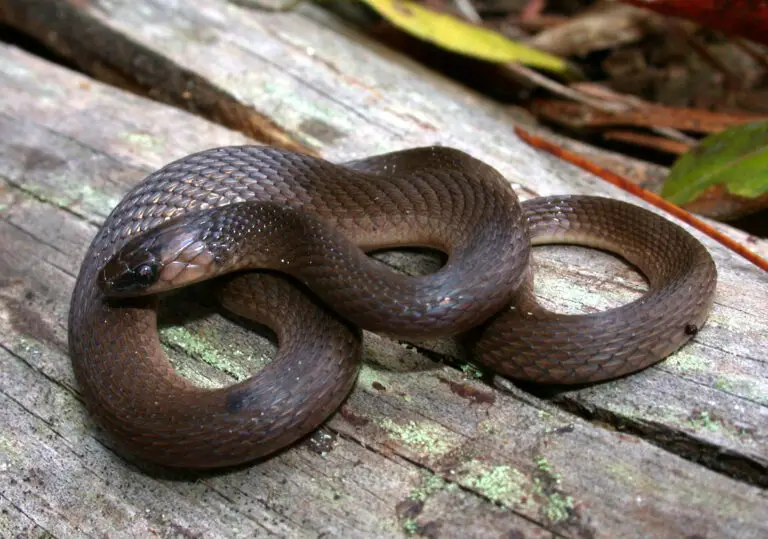
Habitat
The Rough Earth Snake (Haldea striatula, formerly Virginia striatula) is a small, non-venomous, fossorial snake that inhabits a variety of forested habitats with abundant ground cover. It is found across the southeastern United States, from southern Virginia to northern Florida, west along the Gulf Coast to southern Texas, and north into south-central Missouri and southeastern Kansas. These snakes prefer environments with damp soil, such as pine woods, hardwood forests, sparsely wooded rocky hillsides, swamp edges, and grasslands, but usually avoid desert or semi-desert habitats. They are often found under leaves, decaying logs, sun-warmed rocks, or in compost piles and gardens. In urban areas, they can be found in gardens, parks, and vacant lots, where they can reach high densities. They are most often found hiding beneath logs, leaf litter, or other debris.
Diet
Rough Earth Snakes primarily feed on invertebrates, with a diet that consists largely of earthworms. They also consume slugs, snails, sow bugs, insect eggs, and larvae. Their pointed snout facilitates burrowing in moist soil where their prey is found, and they swallow their prey without subduing it.
Behavior
Rough Earth Snakes are secretive and reclusive, spending most of their time underground (fossorial) and rarely seen above ground. They are not aggressive towards humans and have never been known to bite. When disturbed, they tend to stay motionless, and if that doesn’t work, they will quickly move out of the way or attempt to escape. As a defense mechanism, they may defecate and excrete a foul-smelling musk to make themselves less palatable to would-be predators. They are generally solitary and are most active from March to late October, with some nocturnal activity during warm, wet weather conditions.
Reproduction
Rough Earth Snakes are viviparous, meaning they give birth to live young. Mating typically occurs in spring or early summer, and females give birth to 3 to 11 live young in mid- or late summer, usually from late July through September. The newborns are about 10 cm (4 inches) in total length and may have a light-colored neck collar, which is normally lost as they mature.
In summary, the Rough Earth Snake is a small, non-venomous snake that thrives in a variety of habitats with ample ground cover and moist soil. It feeds primarily on earthworms and other invertebrates, exhibits secretive and non-aggressive behavior, and reproduces by giving birth to live young.
Marsh-Brown Snake
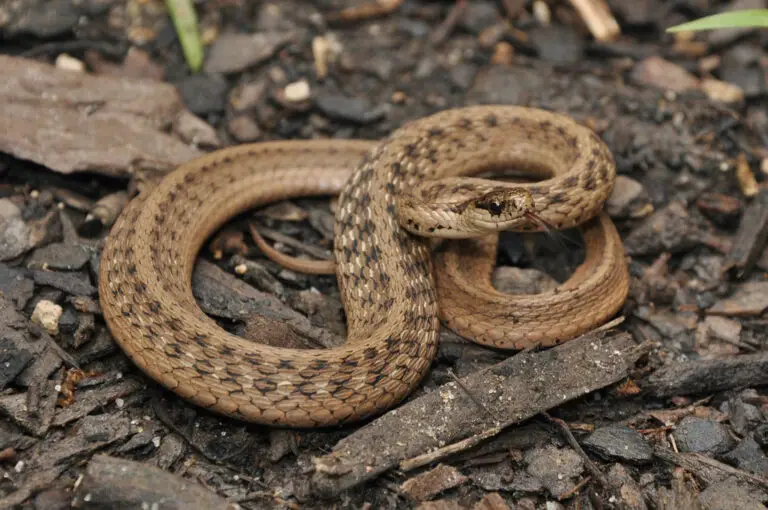
Habitat
The Marsh Brown Snake, a subspecies of the brown snake, is found in various parts of the United States, including Texas. This small, non-venomous snake is characterized by its brown to gray coloration with two rows of black spots and a white underside. It is known to inhabit elevated levees, berms, and other raised surfaces in salt marshes, primarily feeding on earthworms and occasionally slugs. The Marsh Brown Snake is one of the five subspecies of southeastern brown snakes, which are difficult to differentiate without considering their geographical range. The Texas Brown Snake is reddish-brown with dark brown spots around the eyes and can be found in a range of habitats including woodlands, marshes, edges of swamps, golf courses, and moist garden beds.Diet
Its diet mainly consists of slugs, snails, insects, and earthworms.
Behavior
When threatened, it may coil up, raise its head, and strike repeatedly, although its mouth is not large enough to bite humans effectively.Venom
In Texas, the Texas Brown Snake (Storeria dekayi texana) is more commonly referenced. It is a non-venomous snake that is completely harmless to humans.Hognose Snake
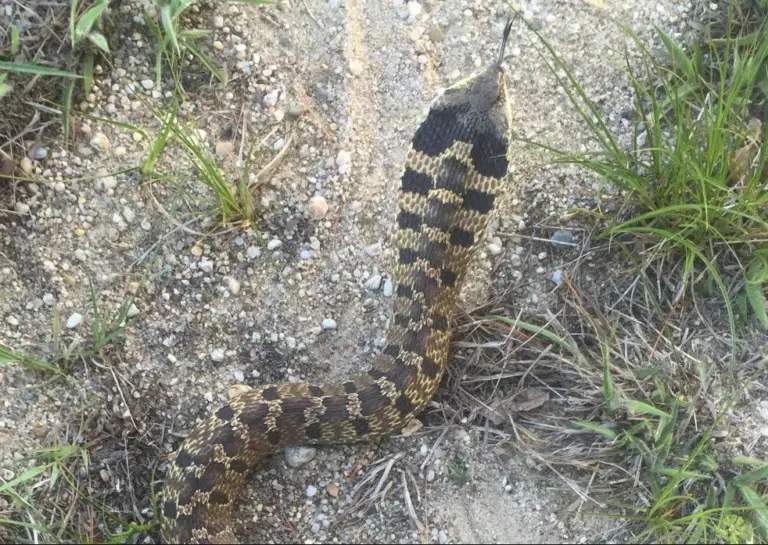
The Eastern Hog-nosed Snake (Heterodon platirhinos) is a fascinating species known for its unique characteristics and behaviors. Here’s a detailed overview based on the provided sources:
Habitat
Eastern Hog-nosed Snakes are adaptable to various habitats but show a preference for areas with sandy or loose soil, which facilitates their burrowing behavior. They are commonly found in dry, open habitats such as fields, forest edges, and sandy areas, including river flood plains, riparian woodlands, and grasslands with sparse vegetation. These habitats are chosen partly for their suitability for the snakes’ burrowing habits and the availability of their prey, primarily toads.
Diet
The diet of the Eastern Hog-nosed Snake is specialized, with a strong preference for toads, which they are uniquely adapted to consume due to their resistance to the toxins toads secrete as a defense mechanism. Besides toads, they will also eat frogs, salamanders, small mammals, birds, and invertebrates if available. Their method of subduing prey involves the use of a mild venom delivered by enlarged teeth at the rear of the mouth, which is particularly effective against amphibians.
Behavior
Eastern Hog-nosed Snakes are diurnal and known for their dramatic defensive behaviors. When threatened, they may inflate their bodies, flatten their heads and necks to resemble a cobra, hiss loudly, and even perform a mock strike with a closed mouth. If these displays do not deter a predator, the snake may resort to playing dead, rolling onto its back and remaining motionless with its mouth open and tongue hanging out. This behavior is so convincing that predators often lose interest, thinking the snake is dead.
Venom
While Eastern Hog-nosed Snakes are often considered non-venomous to humans, they do produce a mild venom that is effective against their prey, particularly toads. The venom is delivered through enlarged rear teeth, but due to the snake’s reluctance to bite and the inefficiency of the venom delivery system in affecting humans, bites are rare and usually not serious. However, individuals with allergies to the venom may experience more pronounced reactions.
Identification
Eastern Hog-nosed Snakes are medium-sized, stout-bodied snakes with a distinctive upturned snout used for digging. They exhibit a wide range of color variations, from yellow, gray, olive, light or dark brown, to black, and may have dark blotches on their back or be uniform in color. Their belly color is typically lighter, and they possess keeled scales. Juveniles display similar but more vivid coloration compared to adults.In summary, the Eastern Hog-nosed Snake is a unique species with specialized behaviors and adaptations for its diet and habitat. Its dramatic defensive displays, specialized diet, and mild venom make it a fascinating subject of study and observation in its natural habitat across various parts of North America.
Rough Green Snake
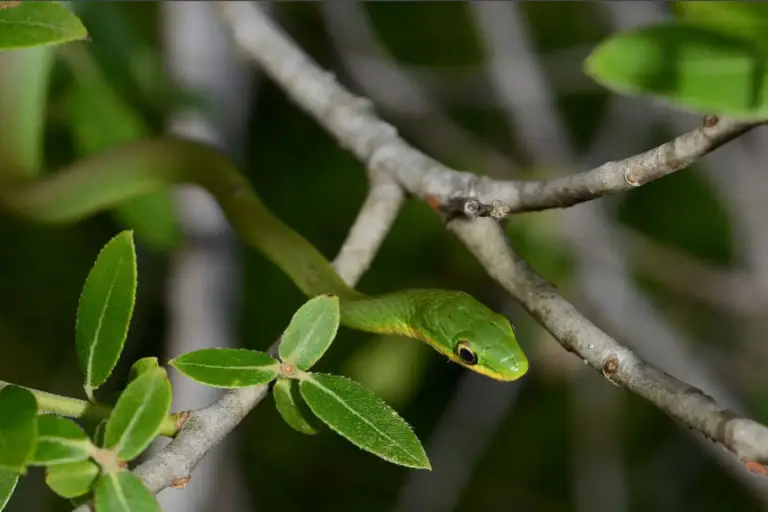
Habitat
The Rough Green Snake is commonly found in a variety of habitats, particularly in open forests and edge habitats. They are abundant along the margins of wetlands and rivers, where they search overhanging vegetation for insects. Their range extends throughout the Mid-Atlantic and Southeast United States, from New Jersey west to central Texas, and south through Florida. They are also found in the Piedmont and Atlantic coastal plain, as well as in northeastern Mexico, including Tamaulipas and eastern Nuevo León. These snakes inhabit moist meadows, overgrown pastures, tallgrass prairies, thickets, vines, shrubs, and woodlands, often near water. They are highly arboreal, frequently climbing in low vegetation, but are also good swimmers and can be found on the ground.
Diet
Rough Green Snakes are carnivorous, specifically insectivorous, with their diet consisting mostly of insects and other terrestrial arthropods. They also consume snails and tree frogs. They use their excellent vision to track down prey and are known to eat spiders, hairless caterpillars, grasshoppers, crickets, beetles, dragonflies, and damselflies.
Behavior
These snakes are diurnal, meaning they are active during the day. They lead a solitary life and are known for their docility, often allowing close human approach without biting. When threatened, they tend to freeze and rely on their camouflage to avoid detection. They hibernate during the colder months, usually from December to February.
Reproduction
Rough Green Snakes are polygynandrous, with both males and females having multiple partners each breeding season. They mate in spring and sometimes again in fall. Females lay 2-14 eggs, which may be laid in communal nests. The incubation period lasts 5-12 weeks, and hatchlings are born fully developed, measuring about 18-20 cm in total length. Females do not provide care for their young after hatching.
Identification
Rough Green Snakes are bright green above with a yellowish belly, which provides excellent camouflage in green vegetation. They have keeled dorsal scales arranged in 17 rows at mid-body and a very thin tail. They can be distinguished from the Smooth Green Snake (Opheodrys vernalis) by the keeled scales, which feel rough to the touch. They are slender and light, with adults typically not exceeding 3 feet in length.
Conservation Status
According to the IUCN, the Rough Green Snake is classified as Least Concern (LC) on the Red List, and its numbers today are stable. However, they suffer from habitat loss due to urban development and may be susceptible to poisoning by pesticides used on their insect prey.
Additional Notes
Rough Green Snakes are also one of the most exploited pet snakes in North America, being collected by the hundreds each year for the pet trade. They are an important food source for local predators, including birds, larger snakes, and domestic cats. When dead, their coloration turns blue. They are the only tree-dwelling snake in the Chesapeake Bay region and are known for their swimming ability.
Texas Rat Snake
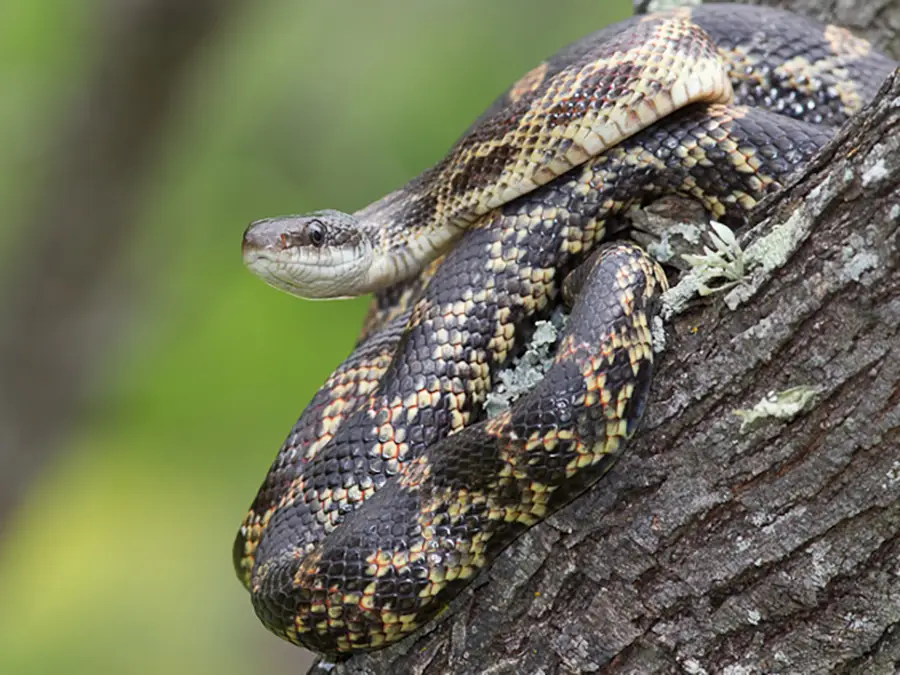
The Texas rat snake, scientifically known as Pantherophis obsoletus lindheimeri, is a subspecies of rat snake that is primarily found in the United States, within the state of Texas, but its range extends into Louisiana, Arkansas, and Oklahoma. This nonvenomous colubrid plays a significant role in controlling rodent populations, making it a beneficial species in its native habitat.
Habitat
Texas rat snakes are generalists when it comes to their habitat preferences. They can be found in a wide range of environments from swamps to forests to grasslands, and even in urban areas. They are particularly adept at climbing and are often found in trees, which allows them to access bird nests. Their ability to adapt to various environments includes brushy, wooded areas, grasslands, and abandoned structures, often leading them to be found in chicken barns due to their predation on eggs.
Behavior
These snakes exhibit a variety of behaviors, including excellent climbing skills and the ability to swim. They are known for their defensive behavior when threatened, which includes vibrating their tail to mimic a rattlesnake, emitting a foul-smelling musk, and biting if necessary. Despite their size, they are relatively timid but can become aggressive when cornered. Texas rat snakes are also capable of a unique form of locomotion that allows them to climb straight up brick walls.
Diet
The diet of the Texas rat snake primarily consists of rodents, birds, and their eggs. They are obligate carnivores and use constriction to subdue their prey before consuming it whole. Their voracious appetite includes mostly rodents, eggs, and birds, but they can also eat lizards, soft-bodied insects, and frogs. This diet contributes to their role as natural pest controllers.
Appearance
Adult Texas rat snakes can reach lengths of 42 to 72 inches, with some individuals growing up to 86 inches. They typically have a brown, tan, or yellow back with brown to olive-green irregular splotching over the entire back. Unlike other rat snakes, they have solid grey heads. Their size and coloration can vary dramatically between different ranges.
Reproduction
Texas rat snakes are egg layers, with females capable of laying up to 20 eggs per clutch. The eggs are laid in a moist and secluded place, such as tree hollows or under rocks, and are left unattended until they hatch. Hatchlings are about 12 to 18 inches long and exhibit similar coloration to adults but are lighter in color.
Conservation Status
While specific conservation statuses for the Texas rat snake are not mentioned, rat snakes, in general, are considered to be of least concern by conservation organizations. However, due to habitat destruction and human persecution, some populations may be at risk. Their beneficial role in controlling pest populations makes them an important species in their ecosystems.In summary, the Texas rat snake is a versatile and beneficial species that contributes to the control of rodent and bird populations in its native range. Its adaptability to various habitats and its role in the ecosystem underscore the importance of conserving this nonvenomous snake.
Eastern Yellow Belly Racer Snake
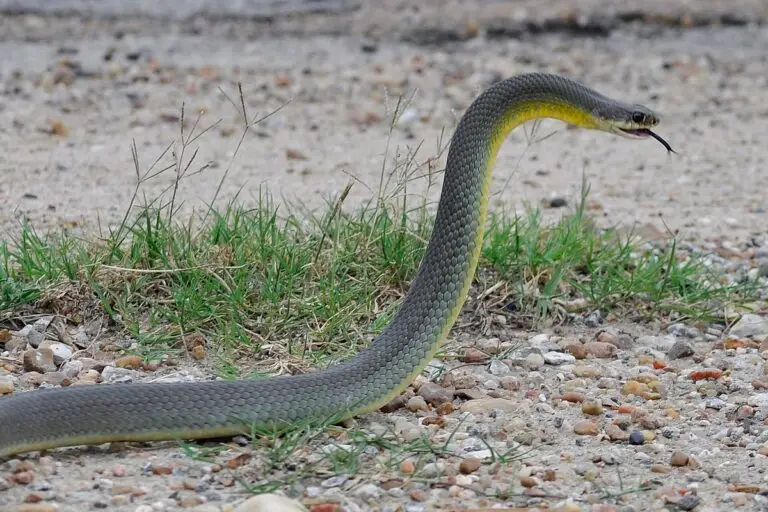
The Eastern Yellow-Bellied Racer (Coluber constrictor flaviventris) is a subspecies of the Eastern Racer, a non-venomous colubrid snake native to North America. This snake is known for its distinctive physical characteristics, habitat preferences, diet, and behavior.
Identification
Adult Eastern Yellow-Bellied Racers are thin-bodied snakes that can reach a total length of up to 1.5 meters (60 inches). They exhibit an olive grey-green coloration on their dorsal side with a yellow underside. Juveniles display a markedly different appearance, featuring a tan or cream-colored body with brown or grey blotches. This coloration gradually changes to the solid olive grey-green of adults as the snake matures, a process that is complete between 1½ to three years of age and when the snake reaches a length of 18 to 30 inches (46–76 cm).
Habitat
The Eastern Yellow-Bellied Racer is found across a wide geographic range in the United States, including states from Montana, North Dakota, South Dakota, east to Iowa, south to Texas, and southeast to Louisiana. It also has isolated populations in Canada. This snake favors open habitats such as grasslands, brushlands, farmlands, ranches, and sparsely treed woodlands. In Canada, its habitat consists of mixed-grass prairie and sagebrush.
Behavior
Racers are diurnal and active predators known for their speed. They are often quick to bite if handled and do not typically fare well in captivity due to their nervous disposition. When alarmed, they may try to escape quickly and sometimes vibrate their tails. If captured, they struggle violently, bite viciously, and may discharge musk and waste matter.
Diet
The diet of the Eastern Yellow-Bellied Racer primarily includes rodents, lizards, frogs, and as juveniles, various kinds of soft-bodied insects. They are also known to feed on baby turtles, small snakes, and the nestlings of ground-dwelling birds or mammals. Adults have been observed to climb trees to consume eggs and young birds. In Saskatchewan, their diet consists mostly of insects such as grasshoppers, as well as other small animals like rodents, birds, and frogs.
Conservation Status
In Saskatchewan, the Eastern Yellow-Bellied Racer is listed as an endangered species, highlighting the need for conservation efforts to protect this unique subspecies and its habitat. In summary, the Eastern Yellow-Bellied Racer is a fascinating snake species with distinct juvenile and adult colorations, a preference for open habitats, and a diet that varies with age. Its behavior is characterized by its agility and speed, making it a proficient predator in its natural environment.
Speckled King Snake
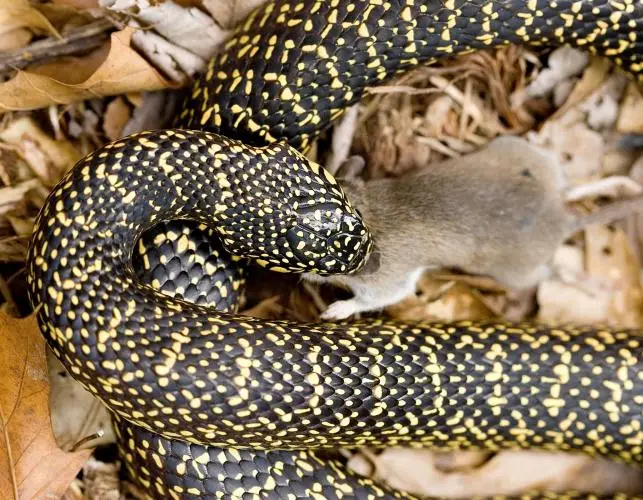
The Speckled Kingsnake (Lampropeltis holbrooki), also known as the “salt-and-pepper snake,” is a nonvenomous species endemic to the United States, recognized for its distinctive black body adorned with yellow or white speckles. This species exhibits a range of behaviors, dietary preferences, reproductive patterns, and habitat choices that contribute to its unique ecological niche.
Habitat
Speckled Kingsnakes prefer wetter environments compared to other kingsnakes, favoring swamps, rivers, and marshes. However, they are also known to inhabit dry areas such as woodlands, grassy fields, and prairies. Their adaptability allows them to thrive in a variety of habitats, from riparian forests to open prairies, and they are found across the central and southern United States, from southern Iowa to the Gulf of Mexico.
Diet
The diet of the Speckled Kingsnake is diverse, encompassing small mammals, birds, frogs, lizards, reptile eggs, and other snakes, including venomous species. They are known for their ability to consume prey as large or larger than themselves, utilizing constriction to subdue their meals. This snake’s diet can vary based on its habitat, with some populations primarily feeding on reptiles and their eggs. Despite being referred to as “cannibalistic,” they typically do not consume other Speckled Kingsnakes.
Behavior
Speckled Kingsnakes exhibit a range of behaviors that aid in their survival and interaction with their environment. When threatened, they may shake their tail like a rattlesnake, expel musk and feces, or bite as a deterrent to predators. Generally, they are docile and may become more amenable to handling over time. They are active from spring through late fall, with activity patterns shifting from diurnal in cooler months to nocturnal during the hotter summer months to avoid extreme temperatures.
Reproduction
Mating occurs from March through May, with females likely depositing eggs in late May and June. The number of eggs can vary significantly, from about six in smaller females to at least 23 in larger ones. Hatchlings appear in August and September. Speckled Kingsnakes reach sexual maturity at approximately two years of age, and courtship involves males competing for females through physical displays and pheromone trails. The gestation period is about 60 days, and females may lay more than one clutch of eggs per season. In summary, the Speckled Kingsnake is a versatile and adaptable species with a broad range across the central and southern United States. Its preference for both wet and dry habitats, varied diet, distinctive defensive behaviors, and reproductive strategies contribute to its success in a wide range of environments.
Eastern Garter Snake
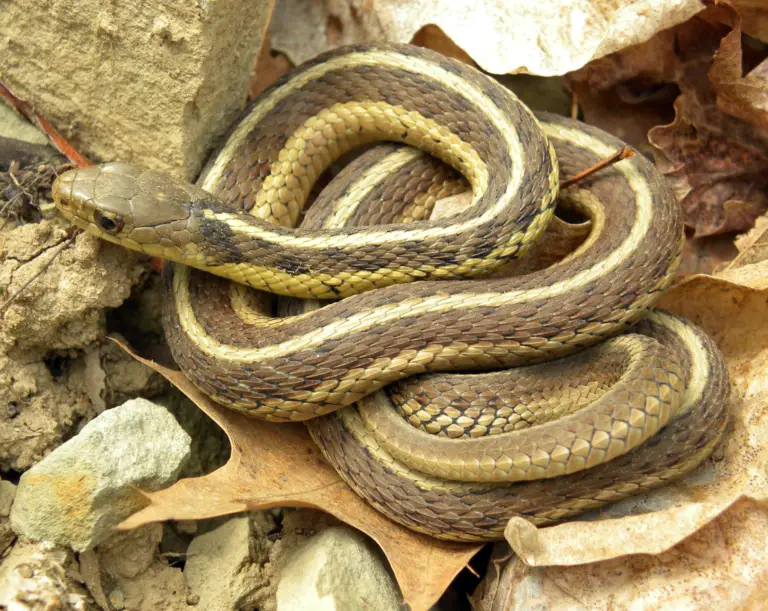
The Eastern garter snake (Thamnophis sirtalis sirtalis) is a medium-sized, non-venomous snake native to North America. Here is detailed information about its habitat, diet, behavior, reproduction, and venom:
Habitat
Eastern garter snakes are highly adaptable and can thrive in a variety of environments. They are commonly found in forests, grassy fields, marshes, and areas near bodies of water such as streams, ponds, and lakes. They also inhabit suburban and urban areas, often seen in gardens and parks. These snakes prefer moist environments but can also be found in drier areas.
Diet
Eastern garter snakes are carnivorous and have a varied diet that primarily includes amphibians like frogs and toads, as well as earthworms, slugs, and fish. They are also known to eat small mammals, birds, and other snakes on occasion. Their diet can vary significantly based on their local environment and available prey.
Behavior
These snakes are diurnal, meaning they are active during the day, but they can also exhibit activity during the night. Eastern garter snakes are known for their ability to adapt to different temperatures and are active for a longer period of the year compared to other snakes. They are generally solitary but can be found in large numbers during the hibernation period in communal dens. When threatened, they may exhibit defensive behaviors such as hissing, striking, and releasing a foul-smelling musk.
Reproduction
Eastern garter snakes are ovoviviparous, which means they give birth to live young rather than laying eggs. Mating occurs in the spring after the snakes emerge from hibernation and sometimes again in the fall. Females can give birth to between 10 and 40 young, typically in the summer. The young are independent from birth and receive no parental care.
Venom
While Eastern garter snakes are not venomous, they do possess a mild neurotoxin in their saliva, which is harmless to humans but can immobilize small prey such as earthworms and amphibians. This neurotoxin is not dangerous to humans, and bites typically result in minimal symptoms, such as slight swelling or itching. Overall, the Eastern garter snake is a common and widespread species known for its adaptability to various environments and its role in controlling pest populations.
Ribbon Snake
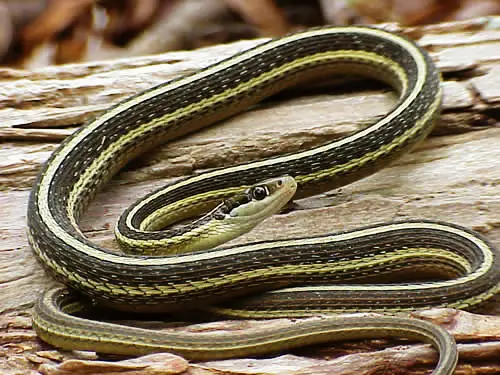
Ribbon snakes, belonging to the species Thamnophis sauritus, are slender, non-venomous snakes native to Eastern North America. They exhibit a variety of behaviors, dietary preferences, reproductive strategies, and habitat choices that are crucial for their survival and reproduction.
Habitat
Ribbon snakes are semi-aquatic and are seldom found far from water. They thrive in and near aquatic habitats such as ponds, swamps, bogs, stream edges, marshes, and lakes, often in areas with high vegetation. These habitats provide both the water necessary for their survival and the vegetation that offers concealment from predators. Ribbon snakes may also be found in wet woodlands, preferring sunny sites and sometimes venturing into open swamps or near woodland ponds.
Diet
Carnivorous by nature, ribbon snakes primarily feed on amphibians such as frogs, toads, tadpoles, and salamanders. They also consume small fish, spiders, earthworms, and newts. Their diet is influenced by their habitat, with a preference for prey found in or near aquatic environments. Ribbon snakes use their auditory and visual senses to hunt, capturing prey with speed and agility.
Behavior
Ribbon snakes are diurnal, most active during the daytime, especially in or near water where they hunt their prey. They are excellent swimmers and can also climb in low bushes. These snakes are generally solitary but may hibernate in groups. They are sensitive to vibrations and have sharp vision, which aids in detecting predators and prey. When threatened, ribbon snakes rarely exhibit aggression; instead, they rely on camouflage or flee into dense vegetation or water to escape. They may also secrete a foul-smelling musk as a deterrent.
Reproduction
Ribbon snakes are ovoviviparous, giving birth to live young once or twice each year, typically in the summer. The breeding season begins in the spring, after hibernation, with males seeking out females for mating. Litter sizes can vary widely, from 4 to 27 snakelets, depending on the subspecies and environmental conditions. The young are born precocial, well-developed, and receive no parental care. Ribbon snakes reach sexual maturity after 2-3 years of age.
Conservation
While ribbon snakes are currently classified as Least Concern (LC) on the IUCN Red List, with stable population numbers, they face threats from habitat loss, pollution, road mortality, and illegal collection. Conservation efforts focus on preserving wetland habitats and ensuring stable amphibian populations, which are crucial for the ribbon snake’s diet.In summary, ribbon snakes are adaptable, semi-aquatic predators with specific habitat preferences and dietary needs. Their survival is closely tied to the health of aquatic ecosystems, making their presence an indicator of wetland quality.
Diamond Backed Water Snake
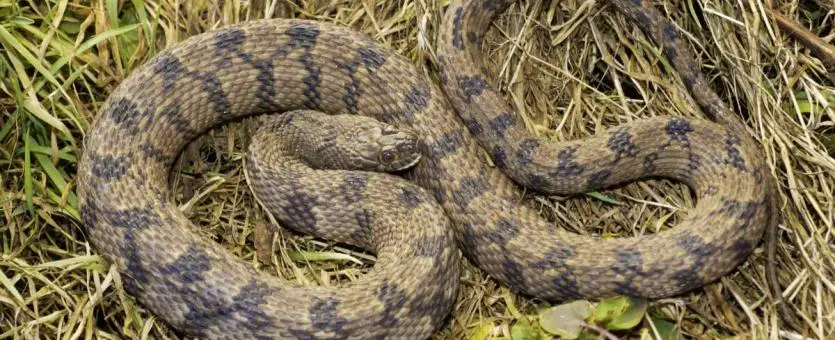
Habitat
Diamondback Water Snakes inhabit a variety of aquatic environments, including rivers, sloughs, ponds, backwaters, and oxbows, with most records from waterways abundant in aquatic vegetation. They are commonly found in areas with overhanging vegetation where they can bask and forage for food. Their range extends across the central United States, predominantly along the Mississippi River valley, and into northern Mexico, including states such as Texas, Oklahoma, Kansas, Iowa, Louisiana, Arkansas, Missouri, Illinois, Indiana, Tennessee, Mississippi, Georgia, and Alabama.Behavior
These snakes are diurnal, active mainly during the day in spring and fall, but can become nocturnal during hot weather. They are known for basking on branches, shrubs, tree roots, and along the banks of waterways. When threatened, they may hiss, flatten their head or body to appear larger, and will bite if physically harassed or handled. Despite their defensive behavior, they are nonvenomous and their bite, while painful due to sharp teeth designed to hold slippery fish, is not dangerous to humans.Diet
The diet of the Diamondback Water Snake consists of a wide variety of aquatic animals, including fish, amphibians, baby turtles, young snakes, worms, leeches, insects, crayfish, and occasionally mammals. They are known to patrol the water along the shoreline in search of food, swallowing their prey alive.Identification
Adult Diamondback Water Snakes can range in length from 30 to 48 inches, with some reaching up to 69 inches. They are heavy-bodied and their dorsal ground color can be greenish, olive, brownish, or grayish. Unlike their common name suggests, they do not have dark diamond-shaped markings down the back but rather a somewhat chain-like pattern. The belly is usually yellow or cream with brown half-moon shaped markings. They are often confused with venomous cottonmouths due to their superficial resemblance, but cottonmouths are not found in all the same areas as the Diamondback Water Snake.Reproduction
Diamondback Water Snakes are ovoviviparous, meaning they give birth to live young rather than laying eggs. Breeding occurs in the spring, and females give birth in the late summer or early fall. Neonates are often lighter in color than adults, making their patterns more pronounced. In summary, the Diamondback Water Snake is a nonvenomous, semi-aquatic snake that plays an important role in controlling the populations of various aquatic species within its habitat. Despite being harmless to humans, they are often mistaken for venomous species and killed out of fear.The Broad Banded Water Snake
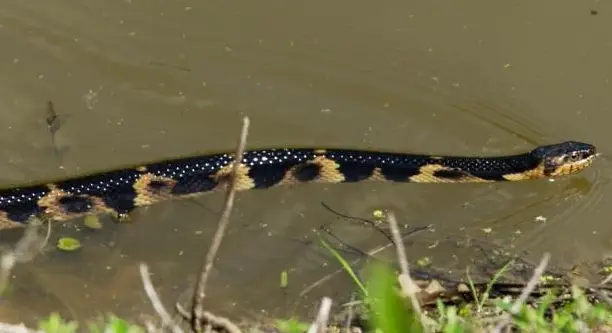
The Broad Banded Water Snake, scientifically known as Nerodia fasciata confluens, is a subspecies of the Southern Water Snake (Nerodia fasciata). This non-venomous, semi-aquatic snake is native to the southeastern United States, including Texas, and is known for its distinctive broad, dark bands that run down the length of its body. Here is a detailed overview of its habitat, behavior, diet, and reproduction based on the provided sources.
Habitat
The Broad Banded Water Snake is typically found in freshwater environments such as lakes, ponds, marshes, streams, and swamps. It prefers heavily vegetated areas and is occasionally seen along canals and streams. This snake is often found near permanent bodies of water and is known to bask in the morning sun but is usually active at night, especially after heavy rains, in search of food.
Behavior
This species displays a range of behaviors that are typical of water snakes. It is a strong swimmer and spends a significant portion of its life in the water. The snake is known to be aggressive when threatened or provoked, often displaying a very aggressive disposition. It may release an unpleasant musky odor or even bite if it feels threatened, although its bite is not venomous. Despite this, if handled gently, it can become very docile. The Broad Banded Water Snake is mainly active during the daytime but can also be nocturnal, especially during the summer’s intense heat.
Diet
The diet of the Broad Banded Water Snake primarily consists of small aquatic creatures. It feeds on fish, tadpoles, frogs, toads, and occasionally crayfish. This diet reflects the snake’s aquatic lifestyle and its ability to hunt in water.
Reproduction
Broad Banded Water Snakes are viviparous, meaning they give birth to live young rather than laying eggs. Mating typically occurs in the spring, and females give birth to live young during late summer. The number of offspring can vary significantly, with reports of 2 to 50 babies being born in a single litter. The young snakes are more brightly colored than their parents and measure 19-26.5 cm (7.5-10.5 in) when born. In summary, the Broad Banded Water Snake is a fascinating species with a strong affinity for aquatic environments. Its aggressive behavior when threatened, combined with its diet and reproductive strategy, makes it a resilient inhabitant of the southeastern United States’ freshwater ecosystems.
Graham's Crayfish Snake
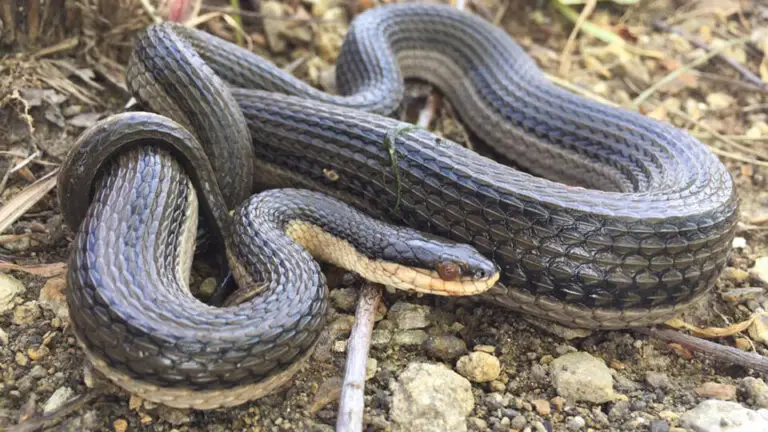
Graham’s crayfish snake, scientifically known as Regina grahamii, is a species of nonvenomous semiaquatic snake in the subfamily Natricinae of the family Colubridae. This species is endemic to the central United States, with its range extending across several states including Arkansas, Illinois, Iowa, Kansas, Louisiana, Mississippi, Missouri, Nebraska, Oklahoma, and Texas.
Description and Identification
Graham’s crayfish snake is a medium-sized snake, typically measuring 18–28 inches (45.7–71 cm) in length, although individuals can grow up to 47 inches (119.4 cm) in some cases. The snake’s ground color can vary from brown to gray, and while it may not have dorsal markings, it often features a faint light or rust mid-dorsal stripe. A prominent light lateral stripe runs lengthwise from the side of the head along the body on both sides, distinguishing it from other species. The belly is usually the same color as the lateral stripes and is typically unmarked, except for a row of dark dots down the center in some specimens. The scales are keeled, and the anal plate is divided.
Habitat and Behavior
Graham’s crayfish snake inhabits a variety of aquatic environments including ponds, sloughs, marshes, floodplains, ditches, and creeks, particularly in prairie or woodland habitats with sandy soil. It is highly dependent on crayfish and their burrows for most aspects of its natural history, utilizing these burrows for overwintering. This species is active from April to October, being primarily diurnal in spring and fall, but may become nocturnal during the hot summer months. Despite its reliance on water, it is also known to utilize terrestrial habitats, especially when hunting or seeking shelter.
Diet
The diet of Graham’s crayfish snake predominantly consists of recently molted crayfish, which are easier to digest due to their soft exoskeletons. However, it is also reported to occasionally consume fish, amphibians, salamanders, tadpoles, and snails.
Reproduction
Graham’s crayfish snake is viviparous, meaning it gives birth to live young rather than laying eggs. Mating occurs in April and May, and females give birth to litters of 4–35 young from late July into September. The newborn snakes are born either in membranes or membranes that rupture during birthing, and they shed their skins immediately after birth.
Conservation Status
While the species is not currently listed as endangered, its populations are declining in some areas due to habitat destruction and other environmental pressures. In Iowa, for example, it is protected by law and designated as a Species of Greatest Conservation Need. Globally, Graham’s crayfish snakes are listed as Least Concern by the IUCN Red List, indicating that they are not currently at significant risk of extinction. In summary, Graham’s crayfish snake is a distinctive, nonvenomous semiaquatic species with a diet heavily reliant on crayfish. Its habitat preferences, reproductive behavior, and conservation status highlight the importance of preserving aquatic and wetland environments to ensure the survival of this and other similar species.
Southern Copperhead Snake
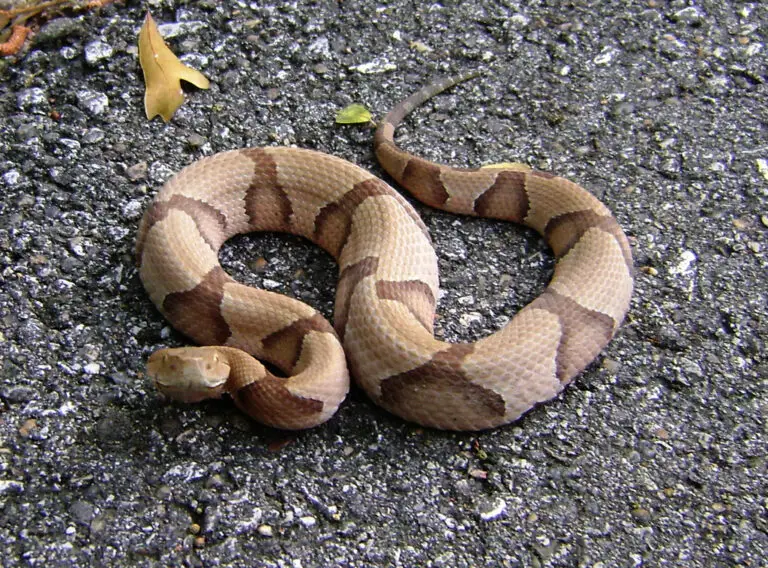
The Southern Copperhead, Agkistrodon contortrix, occupies a range that extends through the eastern United States, including parts of Florida, Texas, and up to southern New England. Its habitat preferences vary across regions. In the mountains, they are commonly found on dry rocky hillsides and may den communally with timber rattlesnakes. In the Coastal Plain, they are abundant in lowland hardwood forests and swamp margins. They are tolerant of habitat alteration and remain common in suburban areas of large cities. In Florida, their habitat is mostly low-lying wet areas around swamps, streams, rivers, and ravines, with a preference for areas along the Apalachicola River. They are also found in deciduous forests, mixed woodlands, coniferous forests, and in the Chihuahuan Desert of West Texas and northern Mexico, they occur in riparian habitats.
Behavior
Southern Copperheads are diurnal but can hunt in the evening or at night, especially during the hotter parts of the season. They maintain their body temperature between 73.4 and 87.8 degrees Fahrenheit and can sometimes be found in small trees to regulate their temperature. Their territory ranges from between 100 to 440,000 square meters, with males having larger ranges than females. They are opportunistic feeders, preying on a variety of animals including insects, mice, lizards, amphibians, and other snakes. They are most active from early spring to late fall and may hibernate during winter, often with other copperheads or even with other kinds of snakes. Males move long distances in search of females during mating season, and females give live birth to 7-10 young in the late summer.
Venom
Copperhead venom is hemolytic, meaning it breaks down blood cells, and is used primarily for subduing prey rather than defense. While the venom is not among the most potent of North American snakes, it can cause significant pain, edema, and localized tissue damage. Bites are rarely fatal but can be more dangerous for children, the elderly, and immunocompromised individuals. The Southern Copperhead’s venom is less toxic compared to other venomous species in Florida, and while bites are extremely painful, they are usually not life-threatening for a healthy adult.
Identification
Southern Copperheads have a distinctive physical appearance. They are fairly large, heavy-bodied snakes with large, triangular heads and elliptical pupils. Their body color ranges from tan to brown with darker hourglass-shaped crossbands. Juveniles resemble adults but have a bright yellow tail tip used for luring prey. Adult males are larger than females. The head is solid brown with few markings, and the body has a light tan or brownish background with darker brown and tan blotches that pinch at the top, giving a triangular shape. Their color pattern provides excellent camouflage amongst leafy litter and debris. In summary, the Southern Copperhead is a venomous pit viper with a broad geographic range in the eastern United States, exhibiting varied habitat preferences and opportunistic feeding behavior. Its venom is hemolytic but not typically lethal to healthy adults, and the snake can be identified by its distinctive hourglass pattern and copper-colored head.
Western Cottonmouth Snake
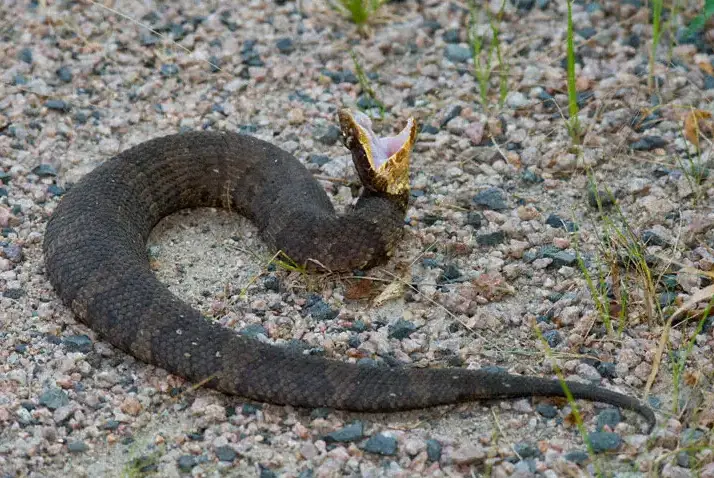
The Western Cottonmouth (Agkistrodon piscivorus), also known as the water moccasin, is a venomous snake native to the southeastern United States. This species is notable for its semi-aquatic nature, being one of the few vipers in the world comfortable both in water and on land. The following sections provide detailed information on the habitat, behavior, venom, and identification of the Western Cottonmouth.
Habitat
Western Cottonmouths are found in a variety of wetland habitats including swamps, lakes, ponds, rivers, and ditches. They prefer lowland swamps, lakes, rivers, sloughs, irrigation ditches, rice fields, and salt marshes but are not confined to moist habitats alone. They can also be found in upland habitats far from aquatic environments, especially during spring and fall as they move to or from hibernating spots.
Behavior
Cottonmouths exhibit several unique behaviors. They are nocturnal, most active at night, but can also be active during daylight hours, especially in the spring and fall. When swimming, they hold their head above water with most of their body barely touching the surface. They employ a unique predatory tactic where young snakes wiggle their tails to mimic worms, attracting prey. Despite their reputation, they generally try to escape if encountered and will only attack humans when threatened. They are known to be territorial during mating season, and females give birth to live young every two to three years.
Venom
The venom of the Western Cottonmouth is hemotoxic, causing tissue damage and disrupting blood clotting. While their bite is rarely fatal to humans, it can cause severe tissue damage if not treated promptly. They are capable of delivering a venomous bite both underwater and on land. Despite their venomous nature, fatalities are extremely rare, and they contribute to less than 1% of all snakebite deaths in the United States.
Identification
Adult Western Cottonmouths can be identified by their dark, grayish-brown color with little or no markings; very old individuals may appear almost entirely black. They have a distinctive white coloration inside their mouth, which is visible when they open their mouth in a defensive posture. They possess a broad, flat head that is distinctly wider than the neck and elliptical pupils that appear as narrow slits by day and widen at night. Juveniles are lighter in color with distinct crossbands and a yellow-tipped tail. In summary, the Western Cottonmouth is a fascinating species with unique adaptations for a semi-aquatic lifestyle. Their behavior, venom, and distinctive appearance make them an interesting subject of study, though caution is advised due to their venomous nature.
Texas Coral Snake
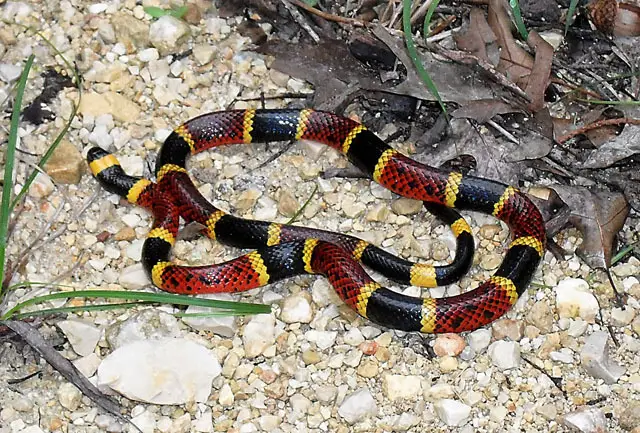
The Texas coral snake (Micrurus tener) can be identified by its distinctive tricolor pattern of red, yellow, and black bands. The red and yellow bands touch each other, which is a key characteristic that sets it apart from nonvenomous mimics that have red bands touching black bands. The saying “Red touch yellow, kill a fellow; red touch black, venom lack” is often used to remember this distinction. The head of the Texas coral snake is solid black, followed by a yellow nape ring, and there are no red bands on the tail or in front of the yellow neck ring. The belly of the snake is not colored differently than the back, and the bands encircle the entire body. Adult Texas coral snakes typically measure between 51-76 cm (20-30 inches) in length, with some individuals reaching up to 121 cm (48 inches).
Habitat
The Texas coral snake is found in various habitats throughout eastern and southern Texas, including the Hill Country along the I-10 corridor from San Antonio to Sonora. It prefers areas with thick plant litter, which provides a humid subterranean environment. This species is also common in garden areas where watered mulch and paving stones offer suitable hiding spots. It does not occur in the Panhandle and barely extends into the easternmost areas of the Trans-Pecos. The Texas coral snake is also found in mixed forests, woodlands, grasslands, savannas, shrublands, and deserts, often in vegetation along rivers and streams.
Behavior
Texas coral snakes are known for their ophiophagy, meaning they primarily feed on other snakes, overpowering them with their highly potent venom. They are not constrictors; instead, they hold onto their prey and envenomate it. These snakes are generally not aggressive towards humans and prefer to retreat rather than fight. Most envenomations occur when people either step on the snake or handle it. They are oviparous, laying eggs in mid-summer with young emerging fully independent after about two months.
Venom
The venom of the Texas coral snake is neurotoxic, similar to that of its cobra relatives, and is over eight times more lethal than that of the diamondback rattlesnake. However, the volume of venom injected is typically small compared to that of a rattlesnake. The venom can cause severe neurological symptoms, but fatalities are rare, especially since the development of antivenin. Despite its potency, the Texas coral snake is not considered as dangerous as rattlesnakes due to its reclusive nature and the rarity of bites. In summary, the Texas coral snake is a venomous elapid with a distinctive color pattern, found in a variety of habitats in Texas. It feeds on other snakes, is oviparous, and while its venom is highly toxic, it is not typically aggressive towards humans.
Western Diamondback Rattle Snake
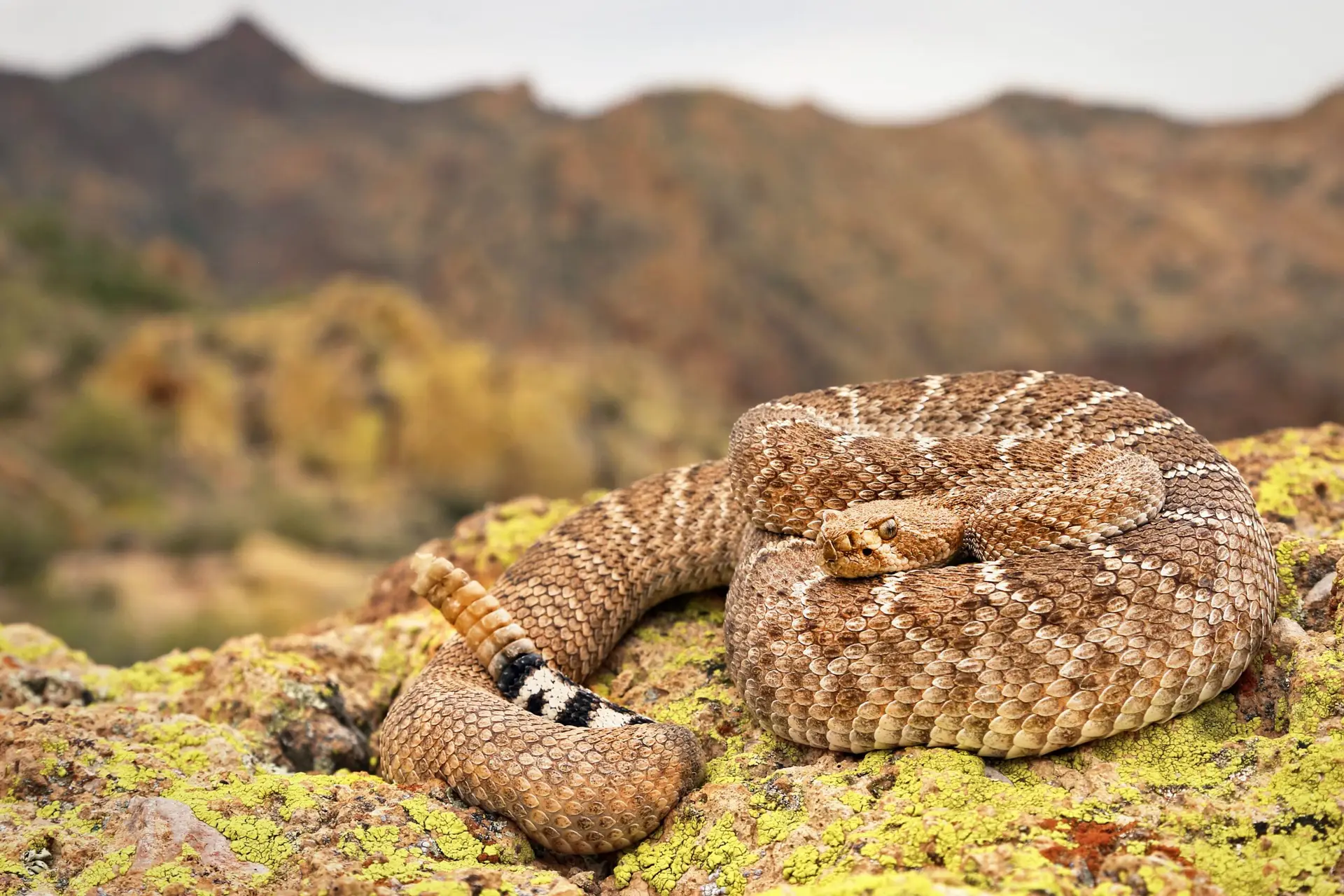
The Western Diamondback Rattlesnake (Crotalus atrox) is a venomous species found in the southwestern United States and Mexico. It is one of the most well-known rattlesnakes due to its widespread range and the frequency of human encounters with it. This species plays a significant role in its ecosystem, primarily as a predator of small mammals, thus helping to control their populations.
Habitat
The Western Diamondback Rattlesnake inhabits a wide range of environments, from flat coastal plains to steep rocky canyons and hillsides. It is adaptable to various vegetation types, including deserts, sandy creosote areas, mesquite grassland, desert scrub, and pine-oak forests. Its habitat extends from central Arkansas and southeastern California in the United States, down to northern Sinaloa, Hidalgo, and northern Veracruz in Mexico.
Identification
Adult Western Diamondback Rattlesnakes typically grow to about 120 cm (4 ft) in length, with some individuals reaching up to 213 cm (7 ft). They are characterized by their distinctive dark diamond-shaped patterns along their back, which are outlined in lighter colors. The tail has black and white bands just above the rattles, which are made of keratin. The snake’s head is triangular, and it has two dark diagonal lines on each side of its face running from the eyes to its jaws.
Behavior
Western Diamondback Rattlesnakes are known for their defensive behavior. When threatened, they will coil, raise the upper part of their body, and rattle their tail as a warning. They are primarily nocturnal hunters, using their heat-sensing pits to detect prey in the dark. Their diet consists of small mammals, birds, and lizards. These snakes are solitary except during mating season or when hibernating in communal dens during winter.
Venom
The venom of the Western Diamondback Rattlesnake is hemotoxic, affecting the blood and heart system, and myotoxic and cytotoxic, causing muscle and cell damage. Bites from this species can be severe and require immediate medical attention. However, not all bites result in venom injection, and fatalities are rare with prompt and appropriate treatment.
Prevention and Interaction
To avoid encounters with Western Diamondback Rattlesnakes, it is advised to stay on well-used trails, wear over-the-ankle boots and long pants, and be cautious in areas where snakes may hide, such as under rocks or in tall grass. If a rattlesnake is encountered, it is best to keep a safe distance and not provoke the animal. Despite their venomous nature, these snakes play a crucial role in controlling rodent populations and maintaining ecological balance. In summary, the Western Diamondback Rattlesnake is a fascinating species that demands respect and caution when encountered in the wild. Understanding its behavior, habitat, and the vital role it plays in the ecosystem can help foster a safer and more appreciative coexistence with these remarkable reptiles.
The Timber Rattlesnake
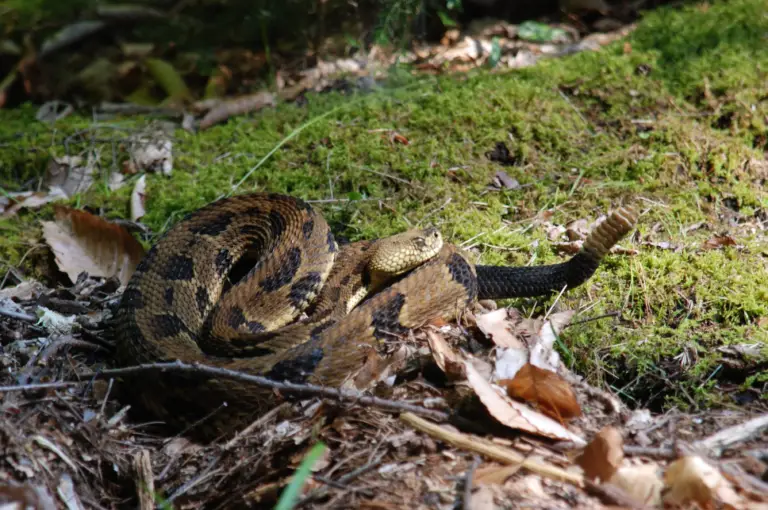
Timber rattlesnakes (Crotalus horridus) are a species of venomous snake found in the eastern United States, ranging from southern New Hampshire, along the Appalachian Mountains to northern Florida, and westward to southeastern Minnesota and southeastern Texas. They are the only rattlesnake species in most of the populous Northeastern United States. Timber rattlesnakes are known for their distinctive rattle at the end of their tail, which they use as a warning signal to potential predators. They are part of the pit viper family, characterized by their heat-sensing pits located between the nostrils and the eyes, which are sensitive to radiant energy and can detect very slight changes in temperature.
Habitat
Timber rattlesnakes prefer moist lowland forests, hilly woodlands, or thickets near permanent water sources such as rivers, lakes, ponds, streams, and swamps. They are also found in deciduous forests in rugged terrain with steep ledges, rock slides, and a nearby water supply in Connecticut. These snakes are an upland species seldom found in elevations less than 500 feet above sea level.
Behavior
Timber rattlesnakes are generally very docile and typically bite as a last resort. They rely on their ability to blend into their surroundings to avoid danger and will remain silent and hide before revealing their position to a predator. They are active during the day, especially on warm sunny days, and are known to be solitary creatures, coming together only during the breeding season.
Venom
The venom of timber rattlesnakes is considered a hemotoxin, which acts to destroy tissue as an aid in digesting its prey. It is potentially one of North America’s most dangerous snakes due to its long fangs, impressive size, and high venom yield. However, this is offset by its relatively mild disposition and long brumation period. Before striking, they often perform a good deal of preliminary rattling and feinting. The venom composition in rattlesnakes shows considerable geographic and ontogenetic variation regarding toxicity.
Conservation Status
The International Union for Conservation of Nature and Natural Resources (IUCN) considers the timber rattlesnake to be a species of least concern, but local populations throughout its geographic range are declining due to hunting and collecting, habitat loss, and vehicle strikes. They are listed as endangered in several states, including New Jersey, Vermont, Massachusetts, Virginia, New Hampshire, Indiana, and Ohio, and threatened in New York, Connecticut, Illinois, Minnesota, and Texas.
Interesting Facts
- Timber rattlesnakes can live as long as 30 years in the wild and as long as 37 years in captivity.
- They are ovoviviparous, meaning that fertilized eggs are retained within the female’s body, and young are born alive.
- Despite their venomous nature, timber rattlesnakes play an important role in their ecosystems by controlling populations of small rodents.
In summary, timber rattlesnakes are a fascinating and important part of North America’s wildlife heritage, contributing to the ecological balance of their habitats. Conservation efforts are crucial to ensure their survival amidst the challenges posed by human activities and environmental changes.
The Western Massasauga Rattlesnake
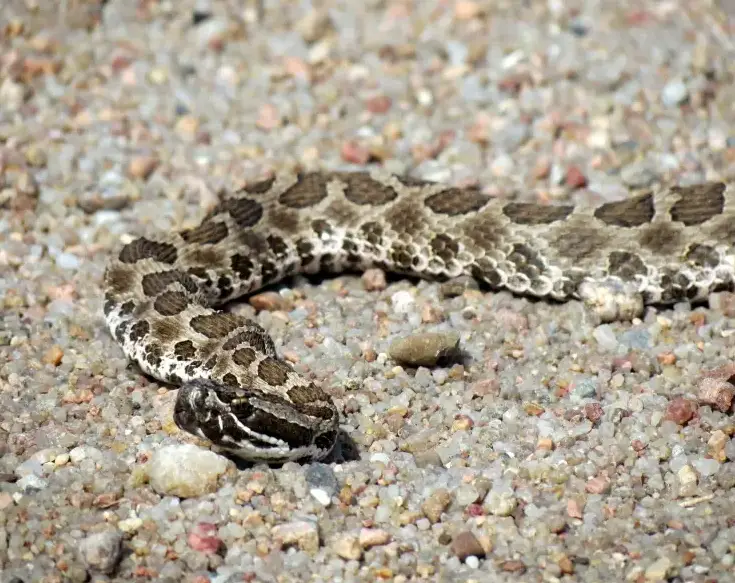
The Western Massasauga (Sistrurus tergeminus) is a species of rattlesnake that inhabits various regions across the United States. Here is detailed information about its habitat, behavior, venom, and conservation status based on the provided sources.
Habitat
The Western Massasauga is found in diverse habitats, including grasslands, prairies, rocky hillsides, and swampy marshlands. In Colorado, its habitat consists of dry plains grassland and sandhill areas. In Iowa, it prefers low, swampy areas close to marshes, lakes, and rivers, and travels to prairies, open grasslands, meadows, or dry woodlands. In Nebraska, they are found in grassland habitats such as tallgrass prairie and grassy fields, favoring moist areas like marshland, wet prairies, and floodplains. They are known to overwinter alone in mammal or crayfish burrows, and in Nebraska, they are exclusively dependent on crayfish burrows for hibernation.
Behavior
The Western Massasauga exhibits diverse behaviors. Some references describe them as slow, sluggish, and passive, relying on their coloration for camouflage to avoid detection. They are generally diurnal except during hot weather when they may become active at dawn, dusk, or even at night. They exhibit migrational behavior between summer and winter habitats and have larger home ranges than their eastern counterparts. They breed in the spring and fall, and females give birth to live young (ovoviviparous) with litters numbering from 5 to 24. The young are venomous at birth and usually more brightly colored than adults.
Venom
The venom of the Western Massasauga is a potent hemotoxin that can cause swelling, necrosis, and severe pain. Although their venom is more potent drop for drop than many larger rattlesnake species, the amount they can deliver is less, reducing their potential for harm. Envenomation can still be fatal if untreated, and immediate medical treatment is advised. The antivenin CroFab can be used to treat severe envenomations.
Conservation Status
The Western Massasauga is listed as “Protected” and a “Species of Greatest Conservation Need” in Iowa. It is designated as a non-game species in Colorado, with a NatureServe rank of G3 (Globally Vulnerable) and S2 (State Imperiled). In Nebraska, the species is listed as Threatened. Habitat loss and road mortality are among the threats to this snake, but it is considered secure as long as drastic changes do not occur in its range. Conservation efforts include managing prairies for crayfish habitat and reporting illegal harassment of the species.In summary, the Western Massasauga is a venomous rattlesnake with a preference for grassland and wetland habitats. It has a varied behavior, is diurnal, and can be nocturnal in hot weather. Its venom is potent, but the snake delivers a relatively small amount. Conservation efforts are in place to protect this species, which faces threats from habitat loss and human activities.
Western Pygmy Rattlesnake
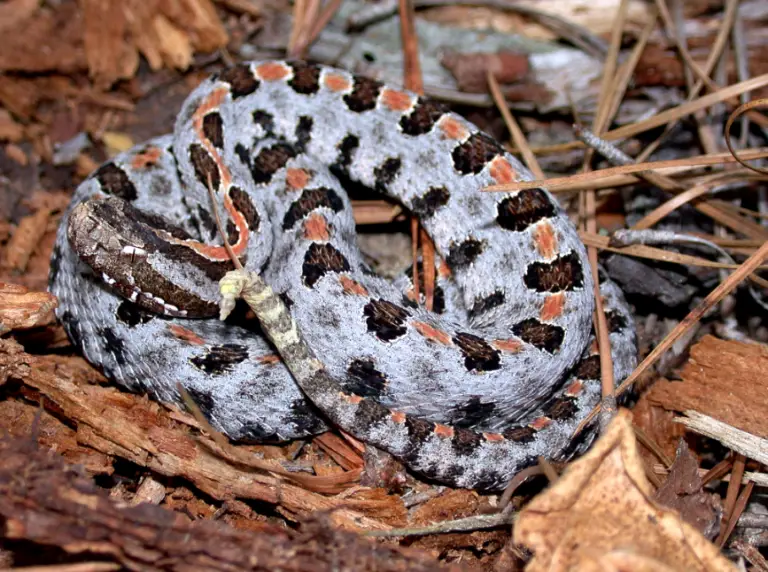
The Western Pygmy Rattlesnake, scientifically known as Sistrurus miliarius streckeri, is a subspecies of the pygmy rattlesnake. Here is detailed information about its habitat, diet, behavior, and reproduction:
Habitat
The Western Pygmy Rattlesnake is found in a variety of habitats across its range. In Arkansas, they are associated with cedar thickets; in Louisiana and east Texas, they inhabit dry pine uplands; and in Tennessee, they are found around the edges of lakes and swamps. They are also known to reside in mixed pine-hardwood forests, near cypress ponds, and close to lakes and marshes. These snakes prefer habitats with standing or running water nearby and are often found in the woodlands of east Texas.
They typically do not reside in dry or arid areas and are skilled swimmers, often staying near bodies of water such as creeks, marshes, and streams. During late spring and early summer, they bask in rocky open areas, near brush piles, or along the sides of roads near forests and glades. In July and August, they tend to be nocturnal and can be observed crossing roads and highways at night.
Diet
Western Pygmy Rattlesnakes have a varied diet that includes lizards, small snakes, mice, and occasionally small frogs and insects. They are also known to consume other tiny snakes, lizards, rodents, bugs, birds, centipedes, and even spiders. In the wild, Pygmy Python, a different species but with similar dietary habits, is recorded as having a diet that consists of 67% reptiles and 33% mammals. The hatchlings feed on small skinks until they are big enough to switch to a rodent diet.
Behavior
This species is solitary except during mating season. They exhibit a behavior called caudal luring when young, using their rattle-tended tail as a lure to attract prey. They are not aggressive and will most likely flee if given a chance to retreat. During the winter, they generally reduce activity drastically by hibernating inside burrows. They do not dig their own burrows but often use those dug by other animals such as gopher tortoises. They can be active during the day or at night, and when disturbed, they generally remain still and rely on their camouflage.
Reproduction
Western Pygmy Rattlesnakes mate in spring or fall, and females typically give birth in late summer to 2 – 30 young. The young are born live, as opposed to laying eggs. They are produced per litter in numbers ranging from three to seven. The neonates are very small when born, typically measuring between 13-18 cm (5-7 in) in length. Males sometimes compete by actual combat for the right to mate with a female. After birth, the young are independent and receive no parental care. In summary, the Western Pygmy Rattlesnake is a small venomous snake that inhabits a variety of environments, primarily in the southeastern United States. It has a diverse diet, solitary behavior except during mating season, and gives birth to live young.
